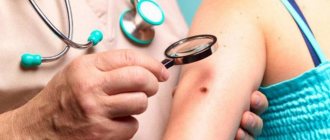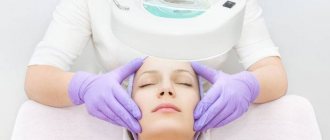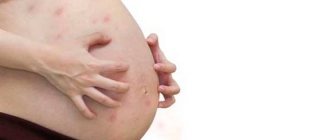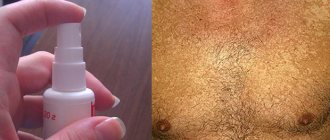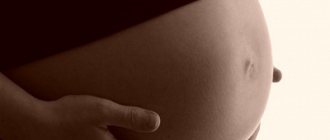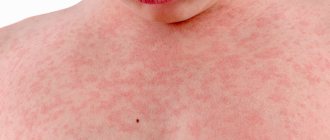Ringworm is a generic name for several dermatological diseases. Their course causes a violation of skin pigmentation, the appearance on the body of characteristic spots and areas of peeling, the formation of which causes severe itching. Their study helps determine the form of skin pathology. The course of the disease in an ordinary person does not cause dangerous complications. Ringworm during pregnancy does not pose a threat to a woman's health, but can have a negative effect on the fetus.
Signs of pityriasis versicolor
Causes of appearance and possible danger
It is worth noting that lichen in pregnant women is quite common. Changes in hormonal levels and decreased immunity directly affect a woman’s overall health. Unfortunately, at the initial stage, lichen can be easily confused with ordinary flaking and dry skin. Not all women will pay attention to such little things. However, if you take a closer look at these types of changes, you will see that the lichen has clear boundaries and a very bright contour, which cannot be said about ordinary peeling and irritation of the skin.
Most types of lichen do not cause any harm to the fetus, but some can lead to miscarriage or stillbirth. Don’t panic: this can only happen if you don’t consult a doctor in time and self-medicate.
If you find any signs of lichen on your body, you need to contact an experienced and qualified dermatologist for a personalized course of treatment. You should not try to cure the disease on your own, as it is unlikely that you will succeed, and you will simply waste precious time.
It should be borne in mind that lichen can be of different types, they all differ from each other in their appearance and respond to treatment differently.
Pityriasis rosea during pregnancy
The most common is pityriasis rosea. Spots of pityriasis rosea appear on the stomach and chest, and disappear on their own after a couple of months. Even if a woman turns to a specialist, she most likely will not be prescribed any treatment. Statistics show that it is pregnant women who are susceptible to pink deprivation.
Pityriasis rosea (or Gibert's disease) looks like pinkish spots with clear edges. There is always a mother plaque that appears first (the largest spot), and the remaining spots are daughter plaques.
If signs of lichen are detected, then it is necessary to consult a specialist for a diagnosis.
Women often confuse lichen with pigment spots, so they cannot do without medical advice!
If the lichen is very itchy, the patient is prescribed approved antihistamines. In other cases, the doctor simply observes how the disease progresses.
We would like to note that itchy skin itself does not indicate that a woman has lichen. The skin can itch for other reasons, which are described in the next article.
Some women practice spot application (only on spots) of Nitrofungin, which can get rid of lichen spots in a few days. In this case, the stains are processed once, and not as indicated in the instructions.
If you have pityriasis rosea, you should follow a certain lifestyle to get rid of this disease as soon as possible:
- It is necessary to avoid wearing very narrow and tight clothes. Clothes made of wool and synthetics need to be replaced with cotton and natural silk. This is only a temporary solution, then it will be possible to return all the usual clothes when the woman completely gets rid of the disease.
- It is recommended to moisturize the affected areas with a cream or natural oil (for example, tea tree oil, olive oil or wheat germ oil). It is important to avoid direct sunlight on these areas.
- It is best to wash with cool water. Hot water will further irritate the skin, causing severe itching. Mild products are used for washing; you should completely forget about the washcloth for a while.
- After each water procedure, a small amount of colchamine ointment should be applied to the affected areas. In this case, it is desirable that the skin is slightly damp and not dry.
- To reduce inflammation, you need to avoid foods such as nuts, eggs, citrus fruits, tea, coffee and chocolate. The fact is that all these products can cause severe allergies, and this is definitely not necessary in the process of treating pityriasis rosea.
- For a month or even two, you will need to completely abandon decorative cosmetics, as they can irritate the skin.
If you follow all these recommendations, then you can get rid of the external manifestations of pityriasis rosea within two months. However, it will not spread to other areas of the skin.
You can watch a consultation with a dermatologist on the issue of pityriasis rosea in pregnant women in this video:
The nature of pityriasis rosea has not been fully studied, but it has been noted that pityriasis rosea appears after stress or weakened immunity.
Treatment of deprivation
Ringworm should be treated based on the degree of neglect, its type, and the course of the disease.
It is possible to prescribe antihistamines due to constant irritation and insomnia due to annoying itching.
Ringworm of a viral nature is treated with antiviral drugs. Treatment of fungal lichen (pityriasis versicolor) is carried out with antifungal agents and ointment is used.
Regeneration and vitamin therapy must be carried out to strengthen the immune system, if there is no allergy and the lichen does not threaten the development and life of the child.
During pregnancy, women should avoid wearing tight underwear and clothing made from artificial fabrics, which cause chafing of the skin and increased sweating.
It is useful to wipe multi-colored lichen and ringworm with table vinegar (9%). For lichen planus, valerian officinalis preparations are used in complex therapy.
For pityriasis versicolor, remove flaky spots with green soap, resorcinol or salicylic alcohol, as well as a 2% iodine solution. Treat with drugs: Mycoseptin or Nitrofungin.
Lubricate problem areas with calendula tincture mixed with regular castor oil (1:1), without affecting healthy skin.
Pityriasis versicolor during pregnancy
Just like pink, pityriasis versicolor (or cauliflower) cannot be dangerous to the fetus. The main thing is proper treatment.
A specialist will be able to select drugs that have low toxicity so that they do not harm the fetus.
Very often, doctors prescribe Nizoral to their patients, as it is completely safe. The ointment is applied to damaged areas of the skin several times a day. In this case, treatment must be continued even when all visible symptoms have disappeared. The fact is that there may be relapses if the therapy is not completed.
For treatment, you can use salicylic ointment, Bifonazole or Clotrimazole ointment from the second trimester.
Signs of pityriasis versicolor:
- Spots of various sizes and colors appear on the skin: yellow, white, pink or even brown. There is no pattern, the spots are completely different and not symmetrical.
- When the skin tans, the spots become significantly lighter. In winter, on the contrary, they darken even more.
- Most often, this type of lichen appears on the back.
It is worth noting that even with the correct diagnosis, this disease can last for years. That is why during pregnancy it is necessary to contact only the best specialists.
Tips for treating pityriasis versicolor from a specialist can be seen in this video:
Skin disease concept
What is ringworm or skin dermatosis? Externally, the disease manifests itself in different ways, but in general the symptoms of the disease can be the same: rashes on the body, itching (severe or tolerable), peeling, as well as a change in color or pigmentation of the area on the skin where the rash appeared.
The causes of this skin disease can be different. First of all, these are malfunctions of the immune system, and during pregnancy this is quite possible, as well as hormonal changes and close contact with a carrier of the infection.
Causes of lichen:
- contact with a pathogen and infection with a fungus or virus (communication with a sick animal or person);
- allergic manifestations;
- lack of vitamins;
- stress, overwork, lack of sleep, low immunity;
- hormonal fluctuations;
- cold, hypothermia.
Ringworm can manifest itself in different ways and, as has already become known, without harm to the fetus. And for mommy this period is not very pleasant, since peeling, itching and the presence of rashes cause a lot of inconvenience.
Ringworm in pregnant women
This is probably the most unpleasant type of lichen, as it is usually located in the hair and on the nail plates. In affected areas, hair falls off at the very root, and the skin peels very much. The disease does not pose any danger to the unborn child if treated with local means.
It is important that the disease does not spread to other family members, since ringworm (synonyms: trichophytosis, microsporia) is contagious. It is necessary to sleep separately and change bed linen regularly. Clothes should be changed twice a day, then washed and thoroughly ironed on both sides with a warm iron.
Detecting ringworm is quite simple: if it is localized in the hair, then round lesions with hair damage will be visible there. Hair will begin to fall out, and the skin will peel off very much.
Sometimes such lichen appears in areas where there is no hair (face, arms and legs). At first, it can be confused with pityriasis rosea, which was mentioned above. But there are still some differences between them. For example, pityriasis rosea does not affect the hands and feet, but ringworm can appear anywhere. In addition, this disease can last a very long time, unlike pink disease, which goes away in a maximum of two months. In order to accurately determine the type of lichen, you need to contact a specialist. Hoping that everything will go away on its own, you can waste a lot of time.
To treat ringworm from the second trimester, drugs such as iodine, Funginal, Micogel, Lotseryl or Miconazole are used topically. If areas where hair grows are affected, it is necessary to shave them off and wash the affected skin well. The duration of treatment is about 2 months, sometimes longer.
This video describes ringworm in children and pregnant women in detail:
Ringworm is a fungal disease, unlike other types of ringworm.
Shingles during pregnancy
This variety is the most dangerous, since it is this type of lichen that can lead to termination of pregnancy. The symptoms of shingles are as follows:
- tingling, numbness and burning sensation in damaged areas: unpleasant sensations, sometimes quite strong;
- bubbles of various sizes appear on the surface of the skin;
- lymph nodes increase in size;
- usually the rash appears on one side (usually on the side), and not all over the body;
- the temperature rises to 39 degrees;
- many symptoms resemble the most common flu.
It should be noted that shingles is a viral infection, also called herpes zoster.
You can only get shingles once in your life. That is, if you are completely cured, then most likely there will be no relapses. The infection is absolutely harmless for those who have already had chickenpox.
When treating shingles in a pregnant woman, the following are used: antiherpetic drugs, drugs to enhance immunity, antipyretics, sometimes analgesics, etc. Acyclovir or Famciclovir is usually prescribed topically. In some cases, physiotherapeutic treatment is also prescribed.
A dermatovenerologist talks about herpes zoster in children and pregnant women and its treatment in this video:
Prevention
During pregnancy, you need to be especially careful about your body, since any disease, even the simplest one, can occur in a more severe form and subsequently affect the child.
In order not to encounter a disease such as lichen, you must adhere to the following rules:
- Support your immunity. Some types of lichen are able to penetrate only into a weakened body.
- Try to have less contact with other people's pets or stray animals. Sometimes you can get lichen from them.
- You should not use other people's towels and combs. Not only lichen, but also some other diseases can be easily transmitted through personal hygiene products.
- Maintain personal hygiene. For example, some types of lichen appear from excessive sweating and lack of hygiene.
- Try to avoid stressful situations and hypothermia. Pityriasis rosea, by the way, most often appears precisely because of this. Moreover, during pregnancy the body is weaker than usual.
- It is necessary to lead a healthy lifestyle: try to move more (regularly exercise for pregnant women, go swimming, etc.) and eat right.
- Visit doctors regularly and undergo examinations.
Animals that are already at home should undergo regular examinations at veterinary clinics. This is especially true for dogs that come into contact with other animals and people.
If it happens that a pregnant woman becomes infected with lichen, it is necessary to ensure that the disease does not spread further. In addition, a pregnant woman urgently needs to undergo a course of treatment from specialists, which will be individual for each woman, depending on the characteristics of her health, stage of pregnancy, condition of the fetus and other factors.
Diet
Treatment of pink lichen during pregnancy and other types of diseases requires diet.
The following foods should be excluded from the diet:
- citrus;
- chocolate, cocoa;
- coffee, strong tea;
- nuts;
- spices;
- canned food;
- carbonated drinks;
- alcohol;
- spices;
- fried foods;
- smoked meats;
- pickles;
- red fruits and vegetables.
You should limit the amount of flour products you consume. Following a diet will help speed up the healing process.


